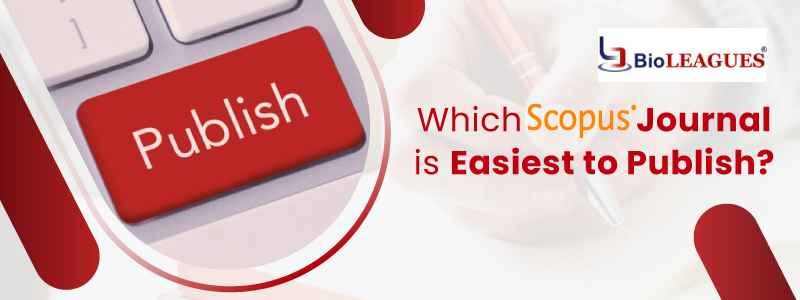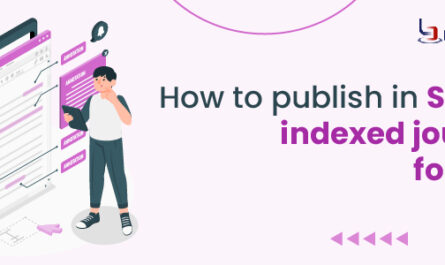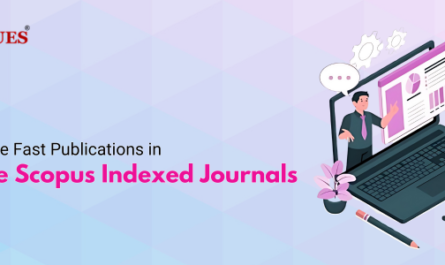Identifying the right Scopus journal for your research can significantly enhance your chances of acceptance and timely publication. This guide provides practical strategies to evaluate journal acceptance rates, review process durations, publication frequency, and preparation of a robust submission package, helping researchers navigate the complexities of academic publishing with confidence.
What Are Journal Acceptance Rates?
Journal acceptance rates refer to the percentage of submitted manuscripts that are accepted for publication within a specific period. This rate can vary significantly between journals and disciplines. A lower acceptance rate generally indicates a more competitive journal, whereas a higher acceptance rate suggests a higher likelihood of publication.
How Can You Find Journal Acceptance Rates?
Journal Websites: Many journals publish their acceptance rates on their official websites. This information is often found in the ‘About’ section, ‘Editorial Policies’, or ‘Author Guidelines’. Journals like those indexed in Scopus often highlight their acceptance rates to attract potential authors.
Editorial Board Statements: Sometimes, acceptance rates are mentioned in editorials or annual reports published by the editorial board. These documents can provide not only acceptance rates but also insights into the journal’s review process and timelines.
Databases & Directories: Platforms like Cabell’s International, Ulrich’s Periodicals Directory, and the SC Imago Journal Rank (SJR) database offer acceptance rate information for various journals. These resources are particularly useful for finding rates for fast publishing Scopus indexed journals.
Professional Societies & Associations: Many academic societies and professional associations compile and publish acceptance rates for the journals they manage. This information is often accessible to members and can be a valuable resource for authors in specific fields.
Author Experiences & Forums: Online academic forums, author communities, and platforms like ResearchGate and Academia.edu often have discussions where researchers share their experiences with different journals, including acceptance rates and review times. These anecdotal reports can provide practical insights.
How To Interpret Journal Acceptance Rates?
Interpreting journal acceptance rates requires understanding what constitutes a ‘high’ or ‘low’ acceptance rate and what these rates imply for your submission strategy.
What Is Considered A High Acceptance Rate?
Discipline-Specific Norms: Acceptance rates can vary widely by discipline. For instance, in some fields like social sciences or humanities, an acceptance rate of 20-30% might be considered high, whereas in medical or engineering fields, an acceptance rate of 10-15% might be the norm.
Journal Reputation & Impact: High-impact journals typically have lower acceptance rates. If a journal with a high impact factor also has a high acceptance rate, it may indicate the journal is highly specialized or emerging in its field. For fast publishing Scopus journals, a high acceptance rate combined with a reasonable impact factor can be an attractive combination.
Submission Volume: Journals that receive a high volume of submissions but maintain a high acceptance rate may have efficient review processes or broader scopes, making them suitable for authors seeking quick publication. Fast publishing Scopus indexed journals often fall into this category, balancing rigorous peer review with timely publication.
Publishing Model: Open access journals sometimes have higher acceptance rates compared to traditional subscription-based journals. This can be due to various factors, including the journal’s funding model, scope, and editorial policies.
How Does Acceptance Rate Affect Your Submission Strategy?
Matching Your Manuscript To The Journal: Authors should align their manuscript’s topic, quality, and novelty with the journal’s scope and acceptance rate. High acceptance rates can indicate a journal’s willingness to consider a broader range of topics or methodologies, which is beneficial for authors seeking fast publishing Scopus journals.
Balancing Quality & Speed: While a high acceptance rate is attractive for ensuring publication, authors should also consider the journal’s review and publication speed. Fast publishing Scopus indexed journals can provide a balance, ensuring that high-quality research is disseminated quickly without compromising on the peer review process.
Strategic Targeting: For early-career researchers or those under time constraints, targeting journals with higher acceptance rates can be a strategic choice. This approach can increase the likelihood of acceptance and timely publication, especially important in competitive academic environments.
How To Evaluate Journal Review Process Duration?
What Is The Importance Of Review Time In Journal Selection?
Timeliness Of Research Dissemination: The speed at which your research is published can affect its relevance and impact. Fast scopus indexed journals ensure that your findings reach the academic community promptly, which is particularly important in fast-moving fields like technology, medicine, and environmental sciences.
Career Advancement: Quick publication can enhance your academic profile, helping in job applications, promotions, and tenure decisions. For early-career researchers, being published in fast publication journals Scopus can provide a competitive edge in a crowded job market.
Funding & Grant Deadlines: Many funding agencies and grant bodies require timely dissemination of research outcomes. Knowing the review duration helps in aligning your submission with these deadlines, ensuring compliance and enhancing the likelihood of future funding.
Strategic Planning: Researchers often work on multiple projects simultaneously. Understanding review timelines allows for better planning and resource allocation. It helps in scheduling submissions, anticipating revisions, and planning for future projects without prolonged delays.
How Can You Determine The Review Process Duration?
Journal Websites: Many journals provide estimated review times on their websites. This information is typically found in sections like ‘Author Guidelines’, ‘Submission Process’, or ‘Editorial Policies’. Look for specific mentions of the average time from submission to first decision, as well as overall time to publication.
Editorial Reports & Annual Reviews: Editorial boards often publish annual reports or editorials that include data on the average review times. These documents can provide insights into the efficiency and transparency of the journal’s review process.
Third-Party Databases & Indexes: Resources like Journal Citation Reports (JCR), the SC Imago Journal Rank (SJR), and other bibliometric databases can provide information on the average review times for various journals. These platforms compile data from multiple sources, offering a comprehensive overview of the journal’s performance.
Author Experiences & Peer Feedback: Platforms like ResearchGate, Academia.edu, and academic forums are valuable sources for anecdotal evidence on review times. Researchers often share their experiences, including the duration of the review process, providing practical insights that may not be available through formal channels.
Direct Inquiry: Contacting the editorial office directly can yield specific information about the review process. Editors can provide details on expected timelines, current backlog, and any factors that might affect review duration.
What Factors Influence Review Process Duration?
Journal Scope & Specialization: Highly specialized journals might have longer review times due to the limited pool of qualified reviewers. Conversely, broader-scope journals might process submissions faster because they can draw on a larger reviewer base.
Peer Review Model: The type of peer review (single-blind, double-blind, or open) can affect the review duration. Open peer review, while promoting transparency, might take longer due to the additional steps involved.
Editorial Workflow & Management: Efficient editorial management systems and workflows can significantly reduce review times. Journals that utilize advanced manuscript tracking systems and automated processes are often faster in handling submissions.
Reviewer Availability & Engagement: The availability and responsiveness of reviewers play a crucial role. Journals that maintain a large and active reviewer pool tend to have shorter review times. Some journals also offer incentives for timely reviews, which can expedite the process.
Manuscript Quality & Completeness: Submissions that are well-prepared, clear, and complete are more likely to undergo a swift review. Manuscripts requiring significant revisions or lacking in clarity can delay the process as they may go through multiple rounds of review.
How Does Publication Frequency Affect Ease Of Acceptance?
What Is Publication Frequency?
Publication frequency refers to how often a journal releases new issues. This can range from weekly, biweekly, monthly, quarterly, biannually, to annually. High-frequency journals publish more issues per year, thereby offering more opportunities for authors to have their work reviewed and published.
How Does High Publication Frequency Influence Ease Of Acceptance?
Increased Opportunities For Submission: High-frequency journals, by publishing more issues per year, provide more slots for articles. This increases the chances of acceptance as the journal has a larger capacity to accommodate new research. For instance, a monthly journal has twelve opportunities a year to publish new papers, whereas a quarterly journal only has four.
Faster Publication Cycles: Journals with higher publication frequencies often have shorter cycles from submission to publication. This is because they need to fill more issues regularly, leading to a streamlined review and publication process. Fast Scopus indexed journals often fall into this category, ensuring that research is disseminated quickly.
Timely Updates In Research Fields: High-frequency publication allows journals to stay current with the latest research developments. This is particularly important in fast-evolving fields such as technology, medicine, and environmental sciences, where timely publication can significantly impact the field’s progress and the researcher’s visibility.
Enhanced Visibility & Citations: Research published in high-frequency journals tends to gain visibility quickly due to the regular release of issues. This can lead to increased citations and greater impact, benefiting the author’s academic profile. For example, researchers often query whether “is empirical economics letters Scopus indexed” to ensure their work appears in a frequently published, reputable journal.
What Are The Challenges Associated With High Publication Frequency?
Quality Control: While high publication frequency can enhance accessibility, it can also pose challenges in maintaining stringent quality control. Authors must ensure that the journal maintains high editorial standards despite the frequent publication schedule.
Reviewer Availability: Increased frequency requires a larger pool of reviewers who can commit to the rapid turnaround times. Journals might struggle to find qualified reviewers, which can sometimes impact the thoroughness of the peer review process.
How To Identify High-Frequency Publication Journals?
Journal Websites: The most direct way to find out a journal’s publication frequency is through its official website. Journals often list their publication schedules in sections like ‘About the Journal’ or ‘Editorial Policies’. Look for statements indicating whether the journal publishes weekly, monthly, quarterly, etc.
Publisher Platforms: Major academic publishers, such as Elsevier, Springer, and Wiley, provide detailed information about their journals, including publication frequency. These platforms often have search filters allowing you to identify journals based on their publication schedules.
Bibliometric Databases: Databases like Scopus, Web of Science, and SC Imago Journal Rank (SJR) provide comprehensive information on journals, including publication frequency. These databases can be particularly useful for identifying fast Scopus indexed journals.
Library Resources: University libraries often have subscriptions to a wide range of journals and can provide information on publication frequency. Librarians can also assist in navigating these resources to find journals that match your publication needs.
Professional Associations: Many academic and professional associations publish journals and provide detailed information on their publication schedules. These associations often list the frequency and other relevant details on their websites or in member communications.
Author Networks & Forums: Engaging with academic forums and author networks such as ResearchGate, Academia.edu, and LinkedIn groups can provide insights from other researchers. These platforms often have discussions about journal experiences, including publication frequency and acceptance rates.
What Are Examples Of High-Frequency Journals?
Weekly Journals: Examples include prestigious journals like Nature and Science, which publish weekly and offer numerous opportunities for researchers to get their work published quickly.
Monthly Journals: Many high-impact journals, such as The Lancet and Journal of the American Medical Association (JAMA), publish monthly. This frequency balances high-quality peer review with regular publication.
Quarterly Journals: While less frequent, quarterly journals like Empirical Economics Letters provide a steady flow of new research. Researchers often verify empirical economics letters indexing to ensure their work is published in a recognized, reputable journal.
How To Prepare A Strong Journal Submission Package?
What Are The Essential Components Of A Successful Submission Package?
Manuscript: The manuscript is the core of your submission package. It should be well-written, clearly structured, and formatted according to the journal’s guidelines. Essential elements include –
Title Page: This should include the title of the paper, the names and affiliations of all authors, and contact information for the corresponding author.
Abstract: A concise summary of your research, including the purpose, methodology, results, and conclusions.
Keywords: Relevant keywords that help index your paper and make it discoverable in searches.
Introduction: An overview of the research problem, objectives, and significance.
Methodology: A detailed description of the methods used in your research.
Results: A presentation of the findings, supported by appropriate tables, figures, and statistical analysis.
Discussion: Interpretation of the results, implications, and how they fit into the broader context of the field.
Conclusion: A brief summary of the findings and their implications.
References: A comprehensive list of all sources cited in the manuscript, formatted according to the journal’s style.
Cover Letter: A cover letter accompanies the manuscript and is an opportunity to make a strong first impression on the editor. It should be professional, concise, and highlight the significance of your research.
Abstract: The abstract is a crucial component as it often determines whether the rest of the paper will be read. It should be clear, concise, and compelling, summarizing the key points of your research.
Figures & Tables: High-quality figures and tables that clearly present your data are essential. Ensure they are labeled correctly and referenced appropriately within the manuscript.
Supplementary Materials: Some journals allow the inclusion of supplementary materials, such as additional datasets, methodological details, or multimedia files. These can enhance the value of your paper. Referring to empirical economics letters Scopus can prove to be of help in this regard.
Author Declarations: Many journals require declarations regarding conflicts of interest, funding sources, and ethical approval. Ensure these are completed accurately.
How To Craft A Compelling Cover Letter?
Address The Editor Properly: Begin with a formal salutation, addressing the editor by name if possible. This shows that you have taken the time to research and personalize your submission.
State The Purpose Clearly: In the opening paragraph, state the purpose of your submission and the title of your manuscript. Briefly mention the significance and relevance of your research.
Highlight Key Findings: Summarize the main findings of your research and their implications. Explain why your study is novel and important, and how it contributes to the field.
Explain The Fit With The Journal: Articulate why your manuscript is a good fit for the journal. Reference specific aspects of the journal’s scope and previous publications that align with your research.
Include A Professional Closing: End with a courteous closing statement, expressing your hope for a positive review and your willingness to respond to any queries. Include your contact information.
How To Write An Effective Abstract?
Be Concise & Specific: An abstract should be a succinct summary of your research. Typically, abstracts are between 150-250 words, depending on the journal’s guidelines.
Cover Key Elements: Include the following components in your abstract:
Background: A brief context for the study.
Objectives: The main goals or hypotheses of the research.
Methods: An overview of the methodology.
Results: Key findings of the study.
Conclusion: The main implications of the findings.
Use Clear & Direct Language: Avoid jargon and complex sentences. The abstract should be easily understandable to a broad audience, including those outside your immediate field.
Focus On Novelty & Impact: Emphasize what makes your study unique and its potential impact on the field. This can capture the interest of the editor and reviewers.
Check Journal Requirements: Adhere to the specific formatting and structural requirements of the journal. Some journals might have specific guidelines for the abstract’s length, structure, or content.
Successfully publishing in Scopus journals involves strategic evaluation of acceptance rates, review durations, publication frequency, and crafting a strong submission package. By focusing on these key factors, researchers can enhance their chances of publication and ensure their work reaches the appropriate academic audience efficiently.




